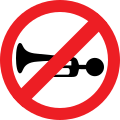Driving in India

India is notorious for its traffic bottlenecks, high population density and because of its high rate of accidents. So, it is best to avoid driving in many places, especially in cities, where public transport fare better. If you do consider driving anyway, especially between cities, consider where to plan to go. Some places can be driven with closed eyes, while other places are very dangerous even with sober driving.
Understand
[edit]
India has major cities with high population density, but road conditions are poor here. The average roads within populated areas are narrow, often potholed and badly marked. National highways are better, but they can be either extremely wide or extremely narrow. Newly-built expressways are faster than national highways, though the quality of expressways vary. The Golden Quadrilateral connecting the four largest cities of Chennai, Mumbai, Delhi and Kolkata with four-laned highways has been completed and is of a reasonable standard. However, improving the quality of the roads does not improve how people drive.
It is very dangerous to drive on the roads in India, as people drive as they like without regard to any rules and the existing rules go unenforced. As of 2023, drivers in India are ranked the worst in the world. Although English is an official language in India, and road signs often use English along with other local languages, knowing some local languages is useful for emergency services (like police, fire, or ambulance) if you wish to drive the horrific thoroughfares. If you are a tourist visiting major cities, it is best to avoid driving in major cities due to traffic congestion, and take a bus, train, or plane instead.
Road signs
[edit]

Indian road signage follows international conventions, especially Vienna Convention on Road Signs and Signals. Road signage generally follows European patterns, but the main difference is that the "No Entry" sign is the "no straight ahead" sign.
Stop signs
[edit]Stop signs in India display both the English word "STOP" and its translation in one of major Indian languages. In some cases, it displays the translation of "stop" only in one of major Indian languages.
Measurements
[edit]India uses the metric system, so the speed limit signs are displayed in kilometres per hour. Americans, Brits, Barbadians and Belizans visiting India must be warned that India uses kilometres per hour, which is about 0.62 miles per hour. Thus a sign of "50" means that you should not drive more than 30 mph.
Warning signs
[edit]Red-bordered white triangles are used as warning signs, similar to European countries.
Licence
[edit]In various Indian states, driving licences are administered by the Regional Transport Authorities/Offices (RTA/RTO). A driving licence is required in India by any person (either a citizen or a foreigner) driving a vehicle on any highway or other road defined in the Motor Vehicles Act, 1988.
This act sets limits on the minimum age for vehicle operation ranging from 16 to 20, depending on specific circumstances.
Applications for a provisional driving license can be made from the age of 16. Valid for driving a moped or gear less motorcycle from aged 16, and a car or any motor vehicle other than a transport vehicle who are aged 18 or older. Thus, you need to be 18 or older in order to drive a car or a motorcycle, and 16 or older in order to drive a moped or a gearless motorcycle.
In India, two kinds of driving licenses are issued:
- a learner's licence, which is valid only for six months, and,
- a permanent licence can be availed only after the expiry of one month from the date of issuance of the learner's licence. (This type of driving licence cannot be received directly.)
When using a learner's licence L-plates must be conspicuously displayed on the front and rear of the vehicle.
To ensure that delays do not apply in the application process, the documents that are to be submitted have to be valid and correct. Thus, this is what you need:
- Proof of age (any one of the below-given documents)
- Birth certificate
- Permanent Account Number (PAN) Card
- Passport
- 10th class mark sheet
- Transfer certificate from any school for any class with date of birth printed on it.
- Aadhaar
Current proof-of-address:
- Rental agreement and electricity bill
- Rental agreement and LPG bill
Foreigners in India may use the holding foreigner licence without the need for any driving tests or being required to hold a learner's license for 30 days.
Rules
[edit]- Drive on the left side of the road — India drives on the left side of the road. Do not drive on the right side unless you are taking over another vehicle. If you are from a country that drives on the right, be careful so as you do not accidentally veer to the wrong side of the road.
- Never turn left or right on red — North Americans visiting India must know that turns on red are illegal in India. You must never turn left, or right, on a red traffic light. Wait until the traffic light is green, then you can turn left or right.
- Speed limits — Speed limits in India vary by state and vehicle type, and are in kilometres per hour. In April 2018, the central government has fixed the maximum speed limit on expressways at 120 km/h (75 mph), for national highways at 100 km/h (62 mph), and for urban roads at 70 km/h (43 mph) for M1 category of vehicles. The M1 category includes most passenger vehicles which have fewer than eight seats. Pay attention to the speed limit! The number inscribed on the red-bordered white circle is in kilometers per hour (km/h), which is about 0.62 miles per hour.
| State/union territory | Motorcycle | Light motor vehicle | Medium passenger vehicle |
|---|---|---|---|
| Andhra Pradesh / Telangana | 50 | No default limit | 65 |
| Maharashtra | 50 | No default limit | 65 |
| Delhi | 30-70 | 25-50 | 20-40 |
| Uttar Pradesh | 40 | 40 | 40 |
| Haryana | 30/50 | 50 | 40/65 |
| Karnataka | 50 | No limit | 60 |
| Odisha | 60 (4 lane or above divided carriageway), 40 (NH & SH passing through Municipal area), 50 (others) | 40 (4 lane or above divided carriageway), 30 (NH & SH passing through Municipal area), 30 (others) | 100 (4 lane or above divided carriageway), 50 (NH & SH passing through Municipal area), 60 (others) |
| Punjab | 35/50 | 50/70/80 | 45/50/65 |
| Tamil Nadu | 60 | 80 100 for four line highways / 120 for six line highways | |
| Kerala | 30 (Near School) / 45 (In Ghat roads) / 50 (City/State Highway/ All other places) / 70(National Highway) / 80 (4-lane highway) | 30 (Near School) / 45 (In Ghat roads) / 50 (City) / 70 (All other places) / 80 (State Highway) / 85 (National Highway) / 90 (4-lane highway) | 30-40 (Near School /In Ghat roads / City) / 50-65 (All other places / State Highway / National Highway) 70 (4-lane highway) |
- Where to sound horn? — In many places in India, "Sound Horn" text is often painted on the back of the truck and the back of the bus. Thus, if you use your horn they will move over slightly so that you may overtake. Honk only once and do it politely, if they do not move simply stay behind them. Do not sound horn in quiet zones (this is marked by a "no horn" sign).<gallery>
- Got an accident? — Remember that in case of an accident, if the situation gets out of hand, then call the police immediately. The emergency number is 112. This will save you from getting a beating from the public. In case of an accident public involvement will surely happen and the guy with a smaller vehicle will get the sympathy. Using your local language may be useful.
- When driving to a small town or village, roads will be too narrow for two lanes, as the villages or towns themselves are not built for cars. — Therefore, traffic coming in the other direction will have to travel on the same path as you. When a car is coming towards you, move to the left side of the road so that you are only taking up half of the road.
Fuel
[edit]
Usually, an attendant will pump the fuel for you at fuel stations, locally called "petrol pumps". You need to engage in a conversation with the attendant for refuelling your vehicle, typically in a local language.
Stay safe
[edit]The emergency number for India is 112.
India is one of the deadliest countries when it comes to driving. Traffic collisions in India are a major source of deaths, injuries and property damage every year. The National Crime Records Bureau (NCRB) 2021 report states that there were 155,622 fatalities, highest since 2014, out of which 69,240 deaths were due to two-wheelers. A study by Insurance Institute for Highway Safety, U.S. shows that the use of seat belts significantly reduces the risks and injuries from road accidents, and yet there is no enforcement on use of seat belts in cars. A study by IIT Delhi points out that the national highways constitute only 2% of the length of roads in India, but they account for 30.3% of total road accidents and 36% of deaths. Thus, it is best to avoid driving in major cities.
A marriage party, minister or religious processions are regular and can hold up traffic. Weddings and religious processions are common occurrences in India. Thus, do not be shy in seeking an alternate route like driving an unpaved road to skip traffic.
While driving on wide roads, be alert. Wrong-way driving (WWD) is a big problem in India.
India has been ranked fourth among the countries with the worst drivers as of 2023, so please be careful on what you are doing when driving.
Car culture also contributes to air pollution in India, as cars typically use diesel fuels.


 Français
Français Italiano
Italiano







